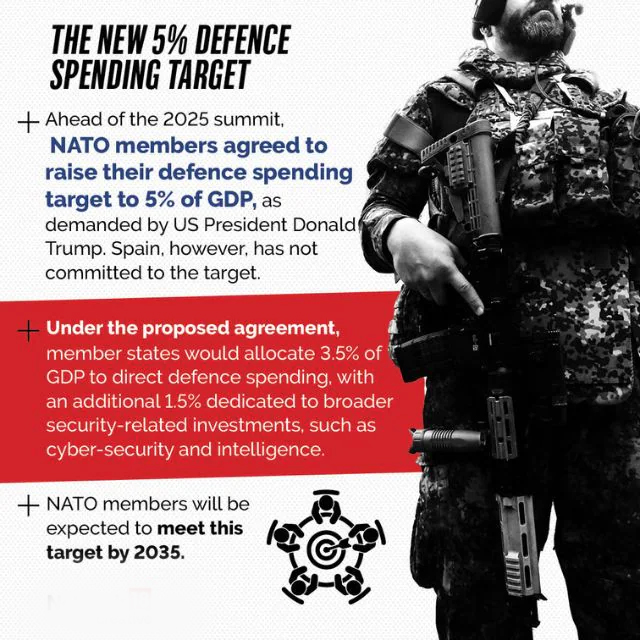Context:
NATO leaders are set to approve a significant increase in defence spending. At the summit in The Hague, members are expected to endorse a plan requiring each country to spend 5% of GDP on defence and security-related investments by 2035. This is a sharp rise from the current 2% goal set in 2014.
Breakdown of the New Spending:
The shift reflects growing security threats. Russia’s ongoing war in Ukraine has raised fears of further aggression. NATO Secretary-General Mark Rutte warned that Russia could be ready to use military force against NATO within five years.
The new target will have two parts:
- 3.5% of GDP for core defence activities such as troops, weapons, and equipment.
- 1.5% of GDP for broader security investments, including infrastructure upgrades, cyber-security, and protection of energy supplies.
This approach aims to make NATO forces better prepared for modern threats and logistical challenges.

Spending Trends and Estimates:
NATO countries spent over $1.3 trillion on core defence in 2024. If the new 3.5% target had been applied, spending would have reached around $1.75 trillion. Reaching the full 5% could require hundreds of billions of dollars more annually.
Defence spending currently varies widely:
- Poland spends over 4% of GDP on defence.
- Spain spends less than 1.3%.
In 2024, 22 of 32 NATO members met the existing 2% target.
Countries will be expected to achieve the new levels by 2035, with a review planned in 2029. NATO has stated there is no opt-out. Spain, for example, plans to spend only 2.1% but will still be monitored.
If countries fail to meet targets, they will be expected to improve spending and capabilities.
EU Support Measures:
The European Union has created supportive policies to help members fund defence increases:
- EU countries can raise defence spending by 1.5% of GDP per year for four years without penalties for budget deficits.
- A €150-billion arms fund has been set up through joint borrowing to provide loans for defence projects.
Some nations are advocating for grants instead of loans, but fiscally conservative countries such as Germany and The Netherlands remain cautious.
Global Comparisons:
Despite higher targets, NATO’s spending is still lower as a share of GDP compared to Russia.
- Russia spent 7.1% of GDP on the military in 2024, amounting to about $149 billion.
- China, the world’s second-largest military spender, allocated 1.7% of GDP.
Defence spending remains a modest share of government budgets in most NATO countries:
- Italy: 3.2% of government spending.
- France: 3.6%.
- Poland: 8.5%.
In Russia, military expenditure accounted for nearly 19% of the budget in 2023.
Conclusion:
This major policy change signals NATO’s determination to strengthen its collective defence in a rapidly evolving security environment. Members will now face the challenge of significantly increasing spending while balancing economic and social priorities.






